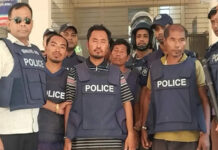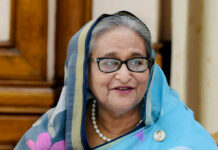Finds a survey on 5,577 households

Forty-two percent of 5,577 households covered by a nationwide survey were found below the poverty line, according to the findings of the study released yesterday.
South Asian Network on Economic Modeling (SANEM) carried out the survey over November and December last year to find out how the socio economic condition of the families changed because of the pandemic
The non-profit organisation had interviewed the same group of households in 2018 and had found 21.6 percent of them to be below the poverty line. This shot to 42 percent last year.
The poverty line, measured by the per capita expenditure per month, is calculated regionally across the country, with rural and urban areas as well as different divisions having different measurements for the poverty line.

SANEM’s findings indicate that 42 percent of the country’s population were spending less than the above-mentioned figures per month, it said.
These findings were revealed in a virtual discussion organised by the organisation.
“The proportion of extreme poor has also increased,” Dr Selim Raihan, executive director of SANEM and a professor at Dhaka University’s economics department, said at the discussion.
The survey found that the proportion of extreme poor jumped to 28.5 percent last year from 9.4 percent in 2018, nationally.
In urban areas, it climbed up from 6.1 percent in 2018 to 19 percent in 2020, and in rural areas, the increase was three-fold from 11.2 percent in 2018 to 33.2 percent last year.
People whose per capita monthly expenditure is below Tk 1,925 -Tk 2,537 in rural areas, and Tk 1,970 -Tk 2,773 in urban areas are considered to be below the line of extreme poverty.
Most of the “new” poor belonged to the service sector, said Dr Raihan. 51.2 percent of the people who dropped below the poverty line last year were in this sector, SANEM found, providing glaring testament to the unemployment scenario during the pandemic.
In 2018, however, this was not the case; back then, agriculturalists made up the majority of the poor.
“Among those who were not poor at all in 2018, only half could retain their economic standing,” Dr Raihan said, adding that the other half dropped down to various stages of poverty, with as many as 20 percent degrading to “extreme poor”.
“Rangpur, Rajshahi and Mymensingh saw the biggest jump in the upper poverty rate from 2018 to 2020,” he said, meaning that those districts experienced the highest increases in the number of poor people.
The highest in the country was in Rangpur, with 57.3 percent of its people being below the poverty line, according to the survey.
“This survey was done at the end of the year. Such findings were concerning because it shows that the impact of the pandemic has extended throughout the year,” said Dr Raihan.
In addition to Dr Raihan, the other authors of the study include Professors Sayeda Haque Bidisha and Mahtab Uddin of University of Dhaka, and research assistants Md Tuhin Ahmed, Mir Ashrafun Nahar and Jabun Naher.
“Expenditure, especially non-food expenditure, fell sharply in 2020,” said Dr Raihan. The extreme poor lowered their expenditure on non-food items by as much as 63 percent. They cut spending on food by 30 percent.
On the other hand, the non-poor, who did not cut back on food unlike others, had to spend more to retain their normal food consumption levels — they spent 17 percent more on food last year than they did in 2018. To compensate, they spent less on non-food items.
Expenditure on education was sacrificed across all income strata, found SANEM.
“Is the backward mobility of the socioeconomic classes temporary or permanent? We need to figure out what the shocks were and whether we can recover quickly,” said Prof MM Akash of Department of Economics at University of Dhaka.
“Was there permanent loss of assets or distress selling? This needs to be questioned,” he said.
“If expenditure on education has decreased, we need to question whether this expenditure will bounce back. I think the expenditure on primary education will recover, because this is borne by the government”, added Dr Akash.
Dr Fahmida Khatun, executive director of the Centre for Policy Dialogue, said, “We see that the support from the government was not sufficient and it could not compensate for the damages incurred by the population.”
“Our development has not been inclusive. Survival mechanism is so little among the poor, that it was not enough to weather a crisis. We have not seen institutional steps to address this,” she added.
Addressing the discussion, Dr Zahid Hussain, lead economist at The World Bank’s Dhaka office, said, “The most important finding is that expenditure on education has decreased and alternative education methods like online education could not substitute in-person education. Learning poverty is not any less important than consumption poverty because we need to think about the future generations.”









